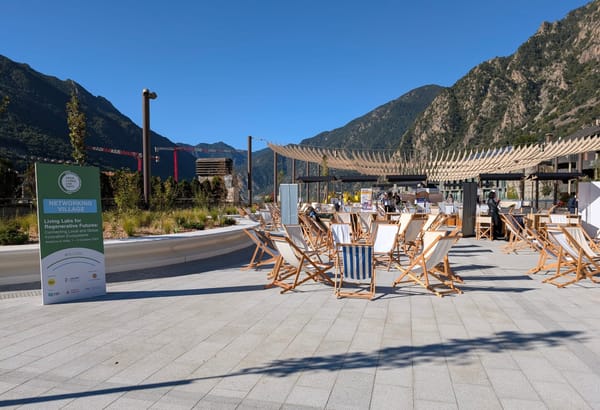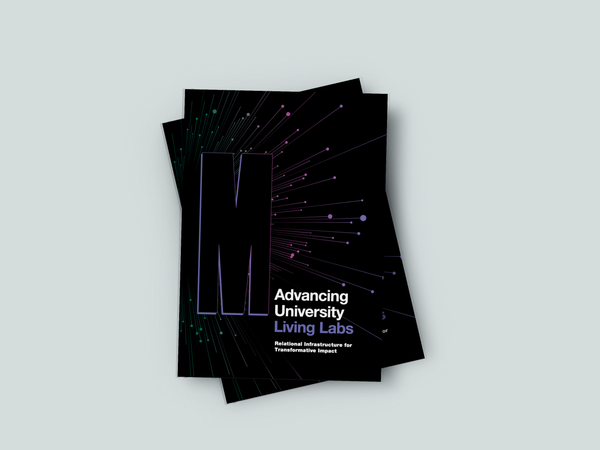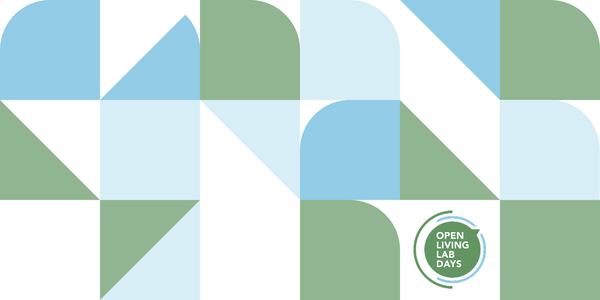Beyond the Lab: landscape scan and synthesis of regional innovation orchestration
Regional innovation doesn't just happen. Exploring the role of orchestration in regional innovation ecosystems - beyond the Lab.

Over the last 15+ years I've been deeply immeshed in questions of how change happen, how we create the conditions for systems change, and how we grow networked models of collective action that tackle complex challenges bigger than any single organisation. Whilst I've been in the weeds of practice around 'Lab' approaches for social, environmental and economic progress, I recently decided to zoom out just a little bit more as I've also been spending a bit of time with our local / regional development initiative in the Upper Yarra (which is a response to the Native Forestry Transition).
Whilst there's some excellent work happening on the ground to connect and support a series of 'innovation working groups' I have also been preoccupied with what happens at the end of a 2 year window of funding for the coordination or backbone team which is driving this work. The risk of this team ceasing at the relatively early stages of building an innovation ecosystem in the Upper Yarra feels significant - without this team, I fear much of the work will slowly peter out.
Asking the crowd

It got me wondering about what models were out there, because whilst Living Labs might be a suitable model for fostering action across a network over time, I know they're not the only model. So, I asked you good humans on Linkedin if you had any ideas, and ho-ly did you show up for this. I ended up standing up a quick google doc as the clarifications and comments rolled in, and we ended up with a bit of a crowdsourced array of models and examples related to 'orchestrating societal innovation ecosystems'. Thank you!!
I asked specifically about orchestrating innovation but with a broad focus: social, economic, environmental, policy etc - not just startup ecosystems. I am interested in the domain of mutli sector collective action, for the likes of challenges we see today - dynamic, interconnected and persistent - climate change, obesity, and of course (given the context) sustainable regional economies.
Delving into the Journals
Next I spent a bit of time going back into the academic journals, and whilst I pulled out quite a few, the four main ones which resonated were:
- Towards a typology of intermediaries in sustainability transitions (Kivimaa et al, 2019) [1]
- Orchestrator types, roles and capabilities – A framework for innovation networks (Hurmelinna-Laukkanen, 2018) [2]
- Governance in and for complexity (GCSI / The Good Shift, 2024) [3]
- Orchestrating innovation networks: Alignment and orchestration profile approach (Hurmelinna-Laukkanen, 2022) [4]
These papers had some useful typologies, capabilities and functions in respect of innovation orchestrators.
Synthesising of Functions
Next I spent a fair bit of time drawing out common language across the examples people shared, the journal articles, and trying to group these.
This isn't a rigorous reseach exercise of statistical analysis, but I started to see some main clusters emerge, especially when viewed through the lens of:
- Medium to long term platform approach (not projects and short term programs)
- Focused on broad concept of innovation applied to places or systemic challenges which may include responses across policy, social dynamics, behaviours, infrastructure, (s0cial) entrepreneurship, narrative development, community development or many other ways of making change.
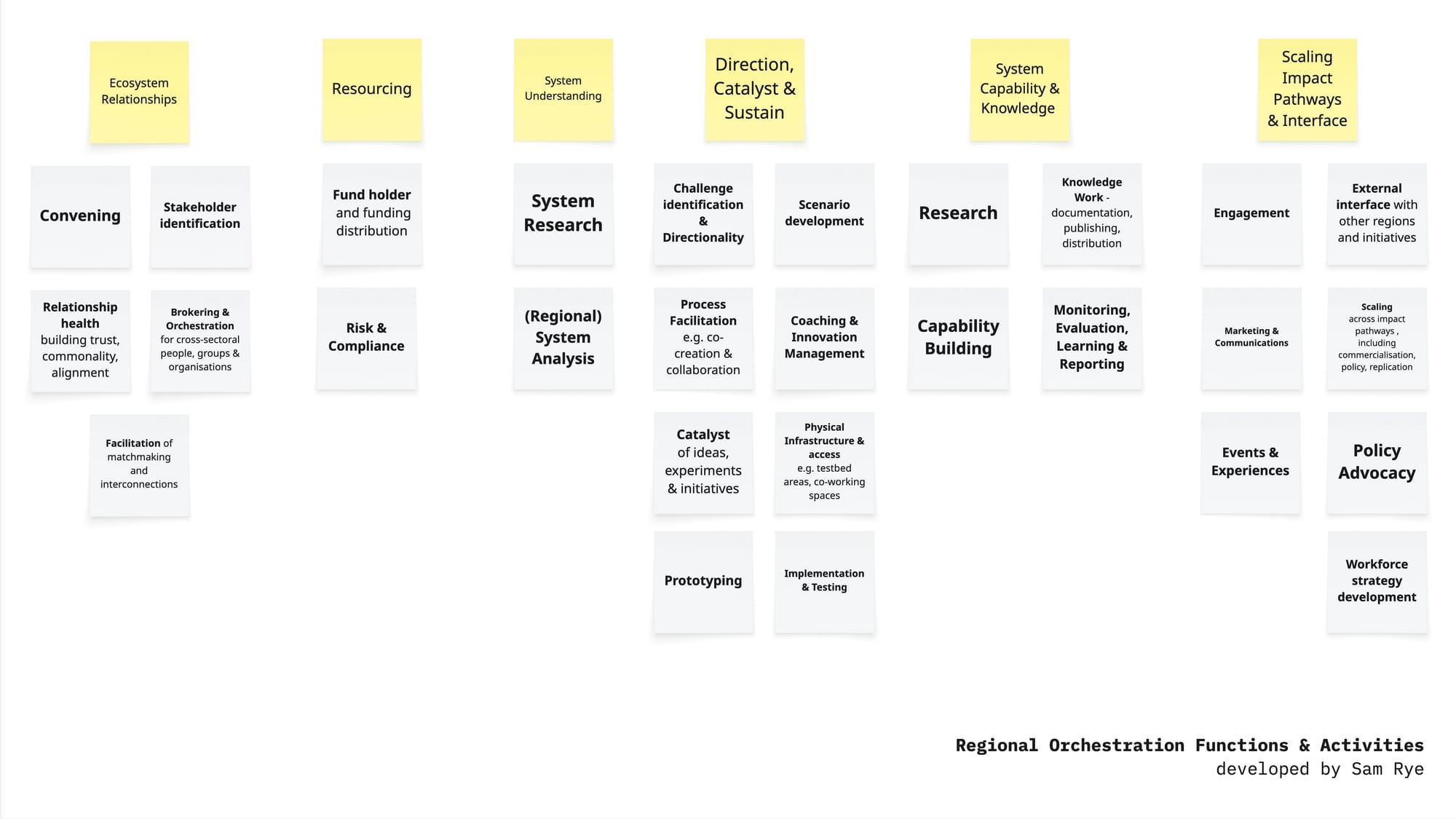
What became clear is that there are many different functions an orchestrating entity might carry out, and that different shapes and focuses would be needed in different situations.
The high level Functions groupings are:
- System Relationships: [tending to the soil] - bringing people together, brokering, and tending to the group to ensure healthy relationship dynamics
- System Resourcing: [adding nutrients] - acting as a holder and distributor of funding, actively applying for or advocating for additional resourcing, and managing the associated legalities and risks
- System Understanding: [checking the pH] - investing in research and participatory actvities to understand the current state of the system, where the acupuncture points or intervention areas might be, and what is needed to unlock latent potential
- System Direction, Catalyst & Sustaining: [tending the fields] - working to build alignment, bring in the right folks, spark and support action, coach and cajole, and sustain innovation over time because good things don't happen overnight
- System Capability & Knowledge: [noticing the patterns] - ensuring learning is the central currency of the innovation network, and working to document and diffuse this over time
- Scaling Impact Pathways & Active Interface: [preparing the produce and the seeds] - working beyond fostering the niches to ensure there are active pathways for scaling up, out, deep and otherwise, whilst also acting as an active interface with other regions and players in Government, Industry and otherwise
The role of Orchestrators in innovation ecosystems can hardly be overstated, especially so in the early stages of innovation ecosystem maturity when there is fragile flows of resources, capabilities and relationships.
Comparison of Orchestrators
It was also clear that there are lots of different names for the Orchestrator - to name but a few, innovation ecosystems platforms, intermediaries, backbones, regional interfaces, innovation engines, hubs, network weavers, and more.
To try to tease apart some of the different examples I was offered, I took a look across published information of some of the common models, and produced this table:
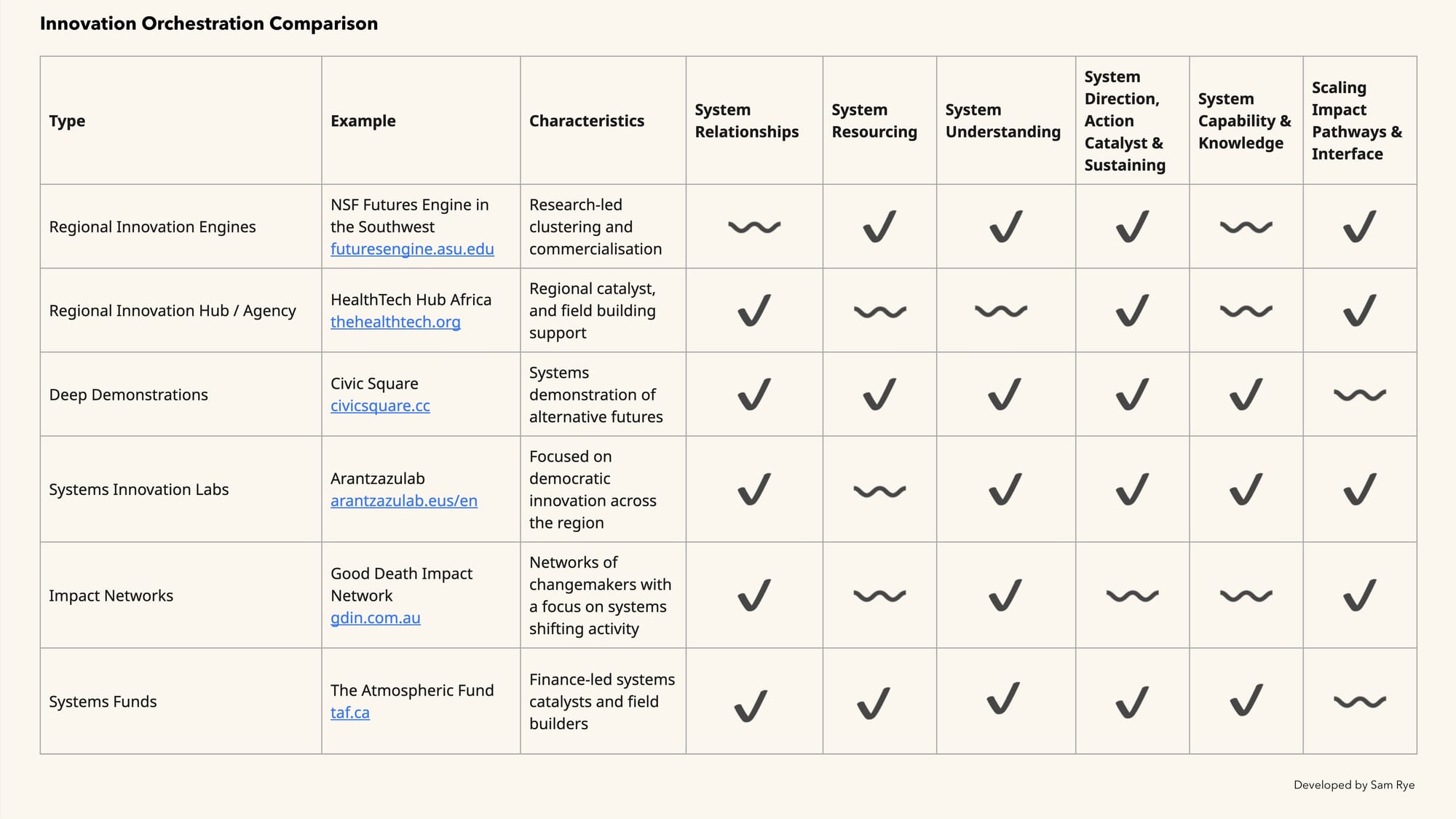
The common formats I looked at were:
- Regional Innovation Engines / Research Clusters
- Regional Innovation Hub / Agency
- Deep Demonstrations
- Systems Innovation Labs
- Impact Networks
- System Funds
Each had a slightly different character and emphasis, and most likely the scope of each orchestrator will depend hugely on their local context, funding, partnerships, and what else is in the area.
For example, in Europe it's clear there is a much stronger regional innovation system made up of all sorts of different entities with specialist functions and funding, and thus standing up innovation initaitives which can rely on those supports, is much easier than in the Australian context where we have a relatively under-developed regional innovation system. [5]
Three Broad Categories of Orchestrators
If I was very crudely grouping the wide array of different orchestration models out there, I would say I see three main groupings on a spectrum / matrix which loosely look like:
- Research & Innovation Brokers - largely working inside the traditional research and innovation (R&I) system - often Universities or National Research Institutions.
- Place & Systems Orchestrators - largely responding to the absence of existing R&I focus, or actively trying to bridge, extend, adapt and translate the traditional R&I activity to specific circumstances, places or systems.
- Funding-led Systems Responses - largely the ambitious, progressive or urgent responses made possible by endowments, philanthropic moves, or large scale funding mobilisation by Government or Industry players.
Upper Yarra Regional Innovation Hub
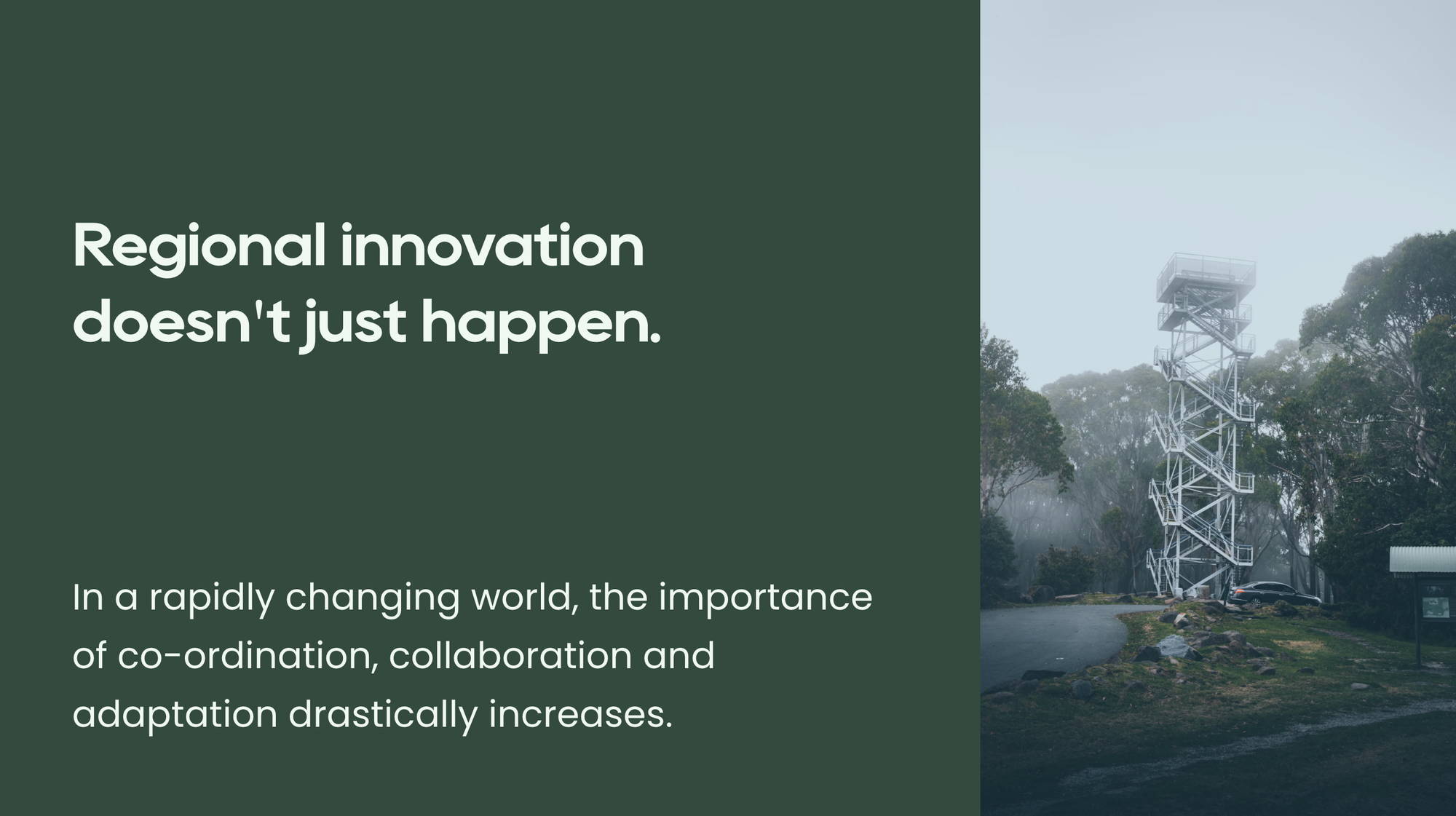
A little before I was able to do the above analysis, I had the opportunity to share with some of the Upper Yarra folks about ideas for developing a regional innovation entity to keep driving things forward. In the interest of sharing where I'd got to, here's the overview slides:
Next Steps
I'm interested if this is useful to people - it was interesting to go down the rabbit hole personally, and I feel like I understand the space better because of it.
I certainly don't feel this is exhaustive, and I'd love to talk to you if you have a better understanding of the space than I do! I'm very interested in reading about comparative analysis on these different modes and possibly, their return on investment if that exists anywhere.
Next steps, personally, is better understanding how we fund these approaches, and how we might best advance something in this shape in the Upper Yarra.
If people find this useful, I might try to write up a bit of a white paper going into the different models in a bit more detail.
Acknowledgements
Special thanks to all the amazing folks who helped crowdsource examples, directly or indirectly, including but not limited to (and in no particular order): Brenna Atnikov, Dave Kim, Gina Rembe, Freda Wells, Freya Bradford, Katrina Mitchell, Gerrit Jan van ‘t Veen, Kate White, Andy Stoll, Russ Gaskin, Sarah Hilker, Lennart Woltering, Karyn Bosomworth, Joanne Lauterjung, Emily Briar, Julien Leyre, Melanie Kahl, Natalia Radywyl, George Aye, Marius Foley, Finaly Batts, Leander Kreltszheim, Cesar Jerónimo Esquinca Enríquez de la Fuente, Adam French, Patricia Bradshaw, Jamie Stenhouse, Duncan Ebata, Samuel Wines & Nora Marketos.
References
[1] Kivimaa, P., Boon, W., Hyysalo, S., & Klerkx, L. (2019). Towards a typology of intermediaries in sustainability transitions: A systematic review and a research agenda. Research Policy, 48(4), 1062–1075. https://doi.org/10.1016/j.respol.2018.10.006
[2] Hurmelinna-Laukkanen, P., & Nätti, S. (2018). Orchestrator types, roles and capabilities – A framework for innovation networks. Industrial Marketing Management, 74, 65–78. https://doi.org/10.1016/j.indmarman.2017.09.020
[3] Shifts, G. (2024, July 23). Governance in and for complexity - The Good Shift - Medium. The Good Shift. https://medium.com/good-shift/governance-in-and-for-complexity-eac108d8b589
[4] Hurmelinna-Laukkanen, P., Möller, K., & Nätti, S. (2022). Orchestrating innovation networks: Alignment and orchestration profile approach. Journal of Business Research, 140, 170–188. https://doi.org/10.1016/j.jbusres.2021.11.084
[5] Kilpatrick, S., & Wilson, B. (2013). Boundary crossing organizations in regional innovation systems: Boundary crossing organizations in regional innovation systems. Regional Science Policy & Practice, 5(1), 67–83. https://doi.org/10.1111/j.1757-7802.2012.01087.x




